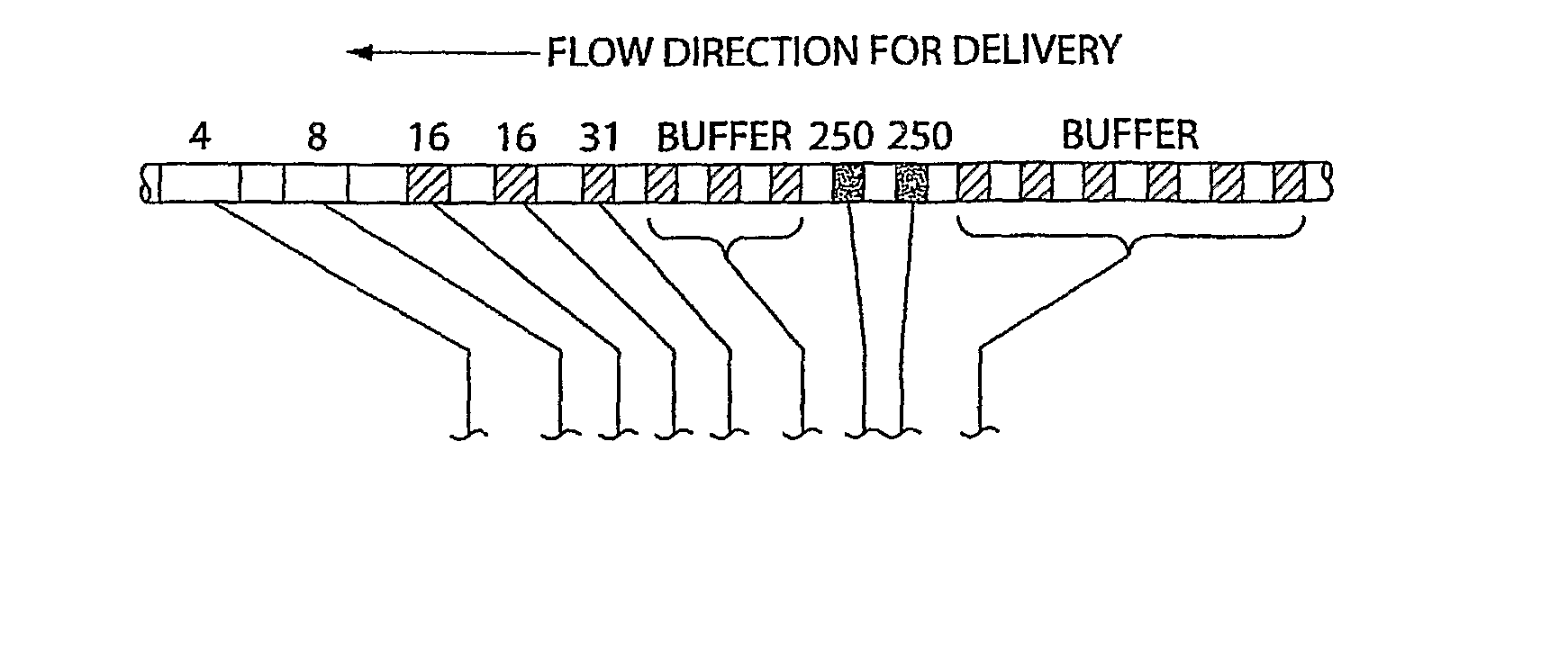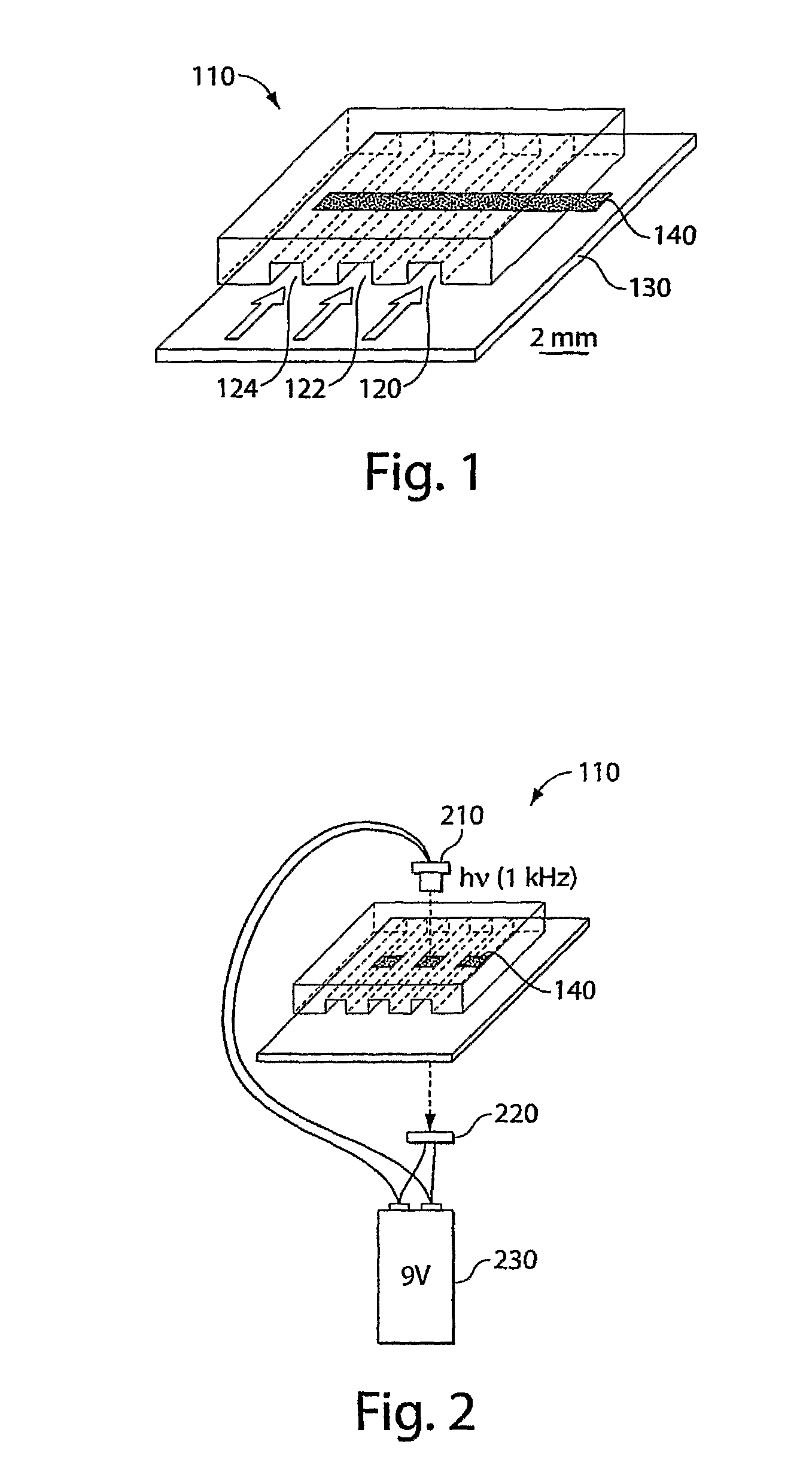Fluid delivery system and method
a technology of fluid delivery system and liquid transfer device, which is applied in the field of fluid delivery system and method, can solve the problems of short shelf life, reduced usefulness of the system in the field, and increased cost and sophistication of fluid delivery to the platform
- Summary
- Abstract
- Description
- Claims
- Application Information
AI Technical Summary
Benefits of technology
Problems solved by technology
Method used
Image
Examples
example 1
Production of a Reagent Cartridge
[0138]Tubes, or cartridges, were prepared by cutting commercially available polyethylene (PE) tubing into 30-cm long units. The two methods investigated for filling the cartridge are illustrated in FIGS. 13 and 14. In the method depicted in FIG. 14 up to six PE cartridges were connected to an array of voltage-gated valves, which were in-turn connected to a −6 kPa vacuum source. Voltage pulses generated via a home-written Labview program operated the voltage-gated valves. Before initiating the reagent loading, the cartridges were filled with washing buffer (0.05% Tween® 20 in PBS) and the valves were activated to pump a 2-cm plug of air into the cartridges. The cartridges were then dipped in the appropriate liquid and a plug of liquid was aspirated into the cartridge by opening the valves. An opening time of 5 sec resulted in a 3-cm long plug or a volume of about 13.5 μL. Between each liquid plug, air was aspirated into the cartridge to separate physi...
example 2
[0142]An experiment was designed and run to evaluate the use of a heterogeneous immunoassay in combination with a cartridge containing a series of fluid plugs. All required reagents, except for the sample, were contained in the cartridge. The cartridge was made as described above in Example 1.
[0143]Photomasks for photolithography were obtained from PageWorks (Cambridge, Mass.). Negative photoresist SU8 was obtained from Microchem (Newton, Mass.). Poly(dimethylsiloxane) Sylgard184 (PDMS) was obtained from Dow Corning (Midland, Mich.). Polystyrene substrates were purchased from NUNC (Rochester, N.Y.). Rabbit, anti-rabbit and mouse immunoglobulin G (IgG) were purchased from Sigma (St-Louis, Mo.), and Alexa-488 donkey anti-sheep IgG was obtained from Molecular Probes (Eugene, Oreg.). A hand-operated vacuum pump and polyethylene tubing (Intramedic PE-60, 0.76 mm internal diameter and 1.22 mm external diameter) were purchased from VWR Scientific Products (Pittsburgh, Pa.). All other chemi...
example 3
Cartridge Storage
[0152]A cartridge may serve as long-term storage for reagents before an assay is performed. The long-term stability of the reagents in the cartridges was evaluated, by preparing about 70 cartridges loaded with a sample of 167 nM anti-rabbit IgG and using them over the course of 12 days. The antibody-containing plugs were 8 cm-long. Immediately after the cartridge preparation, the assay was performed on two parallel chips with 6 cartridges and the fluorescence signal arising from the immunocomplex was recorded. The remaining cartridges were split into three batches, each stored at a different temperature: 4° C., room temperature, and 37° C. Later, the immunoassay was repeated on two freshly prepared chips with four cartridges from each batch. The system illustrated in FIG. 18 can accommodate up to six cartridges in parallel. Two cartridges from all batches were used on each chip, and the average fluorescence signal as a function of the time of storage was plotted (se...
PUM
| Property | Measurement | Unit |
|---|---|---|
| inner diameter | aaaaa | aaaaa |
| inner diameter | aaaaa | aaaaa |
| length | aaaaa | aaaaa |
Abstract
Description
Claims
Application Information
 Login to View More
Login to View More - R&D
- Intellectual Property
- Life Sciences
- Materials
- Tech Scout
- Unparalleled Data Quality
- Higher Quality Content
- 60% Fewer Hallucinations
Browse by: Latest US Patents, China's latest patents, Technical Efficacy Thesaurus, Application Domain, Technology Topic, Popular Technical Reports.
© 2025 PatSnap. All rights reserved.Legal|Privacy policy|Modern Slavery Act Transparency Statement|Sitemap|About US| Contact US: help@patsnap.com



